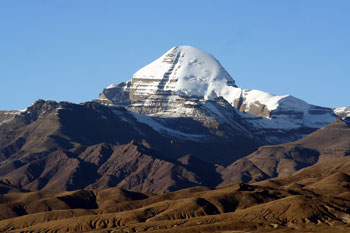Mount Kailash Tour

Mt. Kailash, 6,740 m. is situated to the north of the Himalayan barrier, wholly within Tibet It has the unique distinction of being the most Mount Kailash venerated yet least visited of the world's major holy places. The mountain is the supremely sacred site of four religions and billions of people. Because of its remote location in far western Tibet however, the mountain is visited by no more than a few thousand pilgrims each year. There are no trains or planes going to the region, and by land there are only three, long and difficult, routes. Even today, with rugged over-land vehicles the journey takes weeks, and you must carry all your gasoline and supplies for the entire journey.
Hindus believe Mt.Kailash to be the abode of Lord Shiva. Among the Hindus, Shiva is a character of apparent contradictions. He ,at once the Lord of Yoga and therefore the ultimate enunciate ascetic, yet he is also the divine master of Tantra, the esoteric science that regards sexual union as the most perfect path to spiritual enlightenment. According to legend, immortal Shiva lives atop Kailash where he spends his time practicing yogic austerities, making joyous love with his divine consort, Parvati, and smoking ganja, the sacred herb known in the west as marijuana, Hindus do not interpret Shiva's behaviors as contradictory however, but rather see in him a deity who has wisely integrated the extremes of human nature and thus transcended attachment to any particular, and limited, way of being. For a Hindu, to make the arduous pilgrimage to Kailash and have the darshan (divine view) of Shiva's abode is to attain release from the clutches of ignorance and delusion.
Given its widespread reverence as a sacred site, pilgrims from Nepal, India and Tibet have been making the strenuous journey to Kailash for more than two centuries. With almost no infrastructure in the region, pilgrims need to bring their own transportation and all food and supplies needed for the rugged journey. In addition, the pilgrimage is quite expensive.
The primary purpose of one's pilgrimage to the Kailash region is the ritual circumambulation of the sacred mountain. This undertaking is called parikrama in Sanskrit or kora in Tibetan. Hindus and Buddhists travel in a clockwise direction, while the Bon-po travel counter-clockwise. The traditional parikrama route is 52 km long and can be done comfortably in three days. Some extreme enthusiasts, however, perform prostrations for the entire journey, meaning they travel the route on their hands and knees. This slow and painful rite takes between fifteen and twenty days. On your journey,you will encounter multiple holy peaks: Ravana Parvat, Hanuman Parvat, Padmasambhava, Manjusri, Vajradhara, Avalokiteswara, Jambeyang, Shavari, and Norseng. One continues through Dhira Puk, Shivasthal, and eventually to Dolma, which, at 18,783 feet (5725 meters) is the highest point on the voyage. This pass is said to belong to Deviparvat and is spiritually very significant.
Day to day itinerary
Day 01: Arrival Kathmandu (1300 m.)
Day 02: Kathmandu:
Day 03: Drive to Nylam (150km), 3750m:
Day 04: Rest Day at Nylam, 3750m:
Day 05 Saga/4450m: (Labug-La 5150m, Peku-tso and Saga, 232km)
Day 06: Paryang (4600m) 230 km 7-8 hrs:
Day 07: Drive Paryang to Manasarover (4558m) 277km 8 hours:
Day 08: Puja and drive to Tarchen (14975ft) 40km:
Day 09: Trek to Dehara Puk/5000m:
Day 10: Hardest but Holiest day of your pilgrimage Yatra with Dolma-La (pass) of 18600ft between two valleys:
Day 11: End of Kailash Parikrama and drive to Manasarovar:
Day 12: Drive Pary to Saga (460km) 8-9 hrs
Day 13: Drive to Kerung 6-7 hr.
Day 14: Drive back to Kathmandu (150 km) 06-07 hr.
Day 15: Transfer to airport for your onward flight.
Find Your Travel Mate
to cut down the cost
Come in a group and get special discounted price.
You will be regularly updated if anyone join into the program that you are intrested in.
Click here
to Write us

